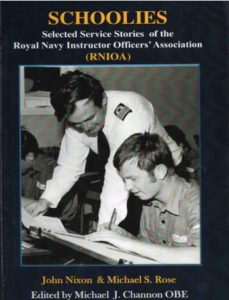- Author
- Book reviewer
- Subjects
- Naval history, Book reviews, Royal Navy
- Tags
-
- RAN Ships
- None noted.
- Publication
- December 2020 edition of the Naval Historical Review (all rights reserved)
Schoolies: Selected Service Stories of the Royal Navy Instructor Officers’ Association. By John Nixon and Michael S. Rose. Hardcover with illustrations, 228 pages. £20, available through Pinewood Hill Publishing.
 Bravo Zulu to John Nixon and Michael Rose, two retired Royal Navy Instructor Officers (RNIOs) who have not only produced Schoolies, but in 2017 founded the Royal Navy Instructor Officers Association (RNIOA) website from which most of the book’s material is sourced.
Bravo Zulu to John Nixon and Michael Rose, two retired Royal Navy Instructor Officers (RNIOs) who have not only produced Schoolies, but in 2017 founded the Royal Navy Instructor Officers Association (RNIOA) website from which most of the book’s material is sourced.
Schoolies has just four chapters. The first begins with a useful timeline of the RNIO and Schoolmaster branches, from 1702 until the IO branch was disbanded in 1996. Then follows a brief history of RN
Education and Training, divided into sections describing the development of naval ratings, artificers, officers, and children attending Royal Naval Schools.
Chapter I provides a worthwhile setting to what follows, but recognition of the development of education and training technologies would have enhanced the background, noting developments from ‘chalk and talk’ through to online learning, simulation and emulation; and importantly, the post WWII adoption of systems training. (Such content does appear in Chapter III.) There is also scant reference to the supporting roles played by non-commissioned Academic Instructor specialists and WRNS (Wren) Educators.
The most interesting and delightful chapter of the book is the second, RNIOA Service Stories, which records, mostly autobiographically, the careers of individual IOs. The accounts illustrate the wide variety of work carried out by Schoolies as educators, and within the sub-specialisations of meteorology, training technology, engineering, and computer science. Reflecting the strong and lasting links between the RN and the RAN and RNZN, the chapter includes the service stories of CAPT Richard Fennessy DSC, RAN, who earned his DSC serving on HMAS Nestor in WWII; and CMDR John Berridge, RNZN. All of the accounts include details of work undertaken, ships and postings served in and the names of fellow officers. It’s here that readers will read some ‘salty stories’, and they might find, as I did, mention of old colleagues, and ships and establishments served in.
The second part of Chapter II acknowledges the close link between the RNIOA and a group of Schoolies who are members of the 100-year old Association of Royal Navy Officers (ARNO). In 2013 this group had a book published about the history and careers of RN Instructor Officers titled Not Just Chalk and Talk: Stories of Schoolies in the Royal Navy. Although similar in content to Schoolies, the two books incorporate the stories of different individuals. In recognition of the authors of Not Just Chalk and Talk, Schoolies presents their service biographies in brief, together with donated images.
Titled ‘RNIOA Articles’, the third chapter of Schoolies contains a sample of articles taken from the RNIOA website. Unlike the previous chapter, these articles focus on one setting, experience or appointment that involved a particularly demanding, enjoyable, or interesting IO role. It therefore covers a wide variety of topics and eras, including the system of RN Lists and the process of officer postings. It is here that, courtesy of the Naval Historical Society of Australia, the remarkable lives of WWI RAN IOs Dr Frederick Wheatley and CMDR Morton Moyes, CBE, are recorded.
The book’s final chapter consists of photographs with captions of scenes, RN ships and people that appear on the RNIOA website but do not appear elsewhere in the book.
Schoolies will hold greatest appeal to IOs who served in the branch, or individuals with close ties with these officers. It will appeal to those who prefer reading a hard copy to reading using a computer screen, for arguably the book’s most useful function is to draw reader’s attention to the RNIOA website, where not only can the same material be read without cost, but provides references and links to other IO related material and is continually being developed.
Reviewed by Martin Linsley




